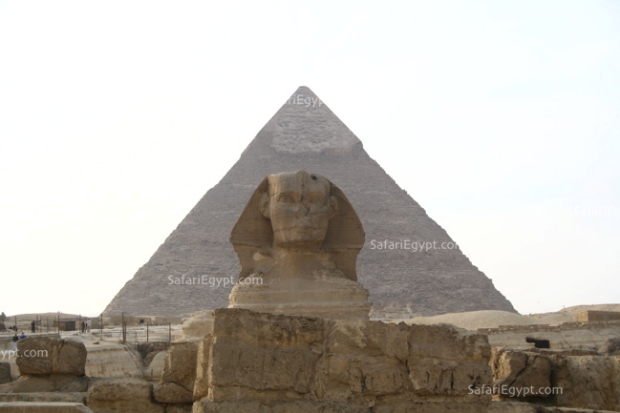|
The Sphinx: Giza Plateau’s Guardian:
Giza plateau offers visitors an exceptional chance to travel through
time. The area unfolds impressive scenes of ancient history not
only manifested in the
Great Pyramids-
one of the Seven Wonders of the World-but also evident in one
the most famous monuments in the World, dating about 4,500 years
old. “The Sphinx” is a limestone, colossal statue resting on Giza’s
gold sand, measuring twenty meters high and fifty-seven meters long.
The breathtaking statue was built in King Khafra’s reign around
2500 BC (also known as King Khafre and Khephren), and is considered
the earliest known sculptor of ancient Egypt. The statue’s face
is a representation of King Khafra, whilst its elongated body is
that of a lion with outstretched paws: the animal symbolizing Kings
in ancient Egyptian art, representing strength and dominance. Archaeologists
believe that the statue was carved of natural rock, amplified by
blocks around the base added from the 18th Dynasty onwards.
The magnificence behind Sphinx’s location lies in the fact that
it faces the rising sun (east) to greet it daily as it shines on
Egypt. Moreover, the statue stands adjacent to the only surviving
temple from the Old Kingdom: Temple of Khafra to bravely guard and
protect it, as well as protecting Giza’s plateau from any intruder.
A visit to Cairo would not be complete without a visit to Giza plateau,
embracing one of the most impressive monuments in the world “Abu
al- Hol”- as locally known -or “The Sphinx”.

King Khafra at a glance:
Khafra was a Pharaoh of the Forth Dynasty (roughly from 2600 to
2500 B.C.), ruling his thriving capital at Memphis. King Kharfa
was Khufu’s son and successor, and it is during his reign, where
the second great Pyramid, Sphinx and the Valley Temple of his Pyramid
were built. Today, visitors come from all over the world to appreciate
the grandness of the great Pyramids, as well as the impressiveness
of the Sphinx. His valley temple, where his body rested before burial
in the Pyramid is the best preserved, and the only surviving structure
of its kind from the Old Kingdom. According to ancient mythology,
Ra was the pre-eminent form of the sun God, and so, the King’s name
Khaf-Ra means “rising like the sun”, explaining why the statue was
built on the eastern side of Giza’s plateau with its face directly
facing Egypt’s rising sun.
The legend behind the name “Sphinx”:
“Sphinx” is a Greek word, translating to “strangler”. Greek legend
tales that a Sphinx was a monster, who asked a riddle and devoured
those who failed to answer it correctly. Thus, Egyptians refer to
the statue as “Abu al-Hol”, which translates to the “father of terror”.
In Greek legends, Oedipus was questioned the following by Sphinx
“What is that which is four-footed, three-footed and two footed?”
Oedipus guessed correctly that it was “man”, as the child crawls
on hands and feet, the adult walks, and the elderly walk with the
aid of a third leg: stick. It was then believed that Sphinx threw
itself from a mountain, as it usually devoured those who failed
to answer its riddles. On the other hand, ancient Egyptian legend
speaks of Thutmose IV- a prince belonging to the 18th Dynasty, dating
to about 1400 BC- who fell asleep under the shades of the Sphinx
after a long journey in the sunny desert. He dreamt that Sphinx
promised him Kingship, on the condition of cleaning away the sand,
as it was choking it. Thutmose obeyed Sphinx’s request and consequently,
was crowned King to build an altar between Sphinx’s paws known as
“Dream Stela”, which reads that the prince remembered the dream
when he woke up and cleared the sand. The Dream Stela is still visible
to visitors until the present day.
Facts about The Sphinx:
There is a general misconception among locals and tourists alike
that Napoleon’s French army or the Mamluks shot off Sphinx’s nose.
However, archeologists clarified that Sphinx’s nose was in fact
lost some time before the 15th Century. Originally, The Sphinx had
a nemes, which is the ancient royal head cloth, a cobra above the
forehead, and a false beard, which was an indicator of royalty.
However, the beard fell off and some of the original features of
the Sphinx are now displayed in the British Museum in London.
|
|

